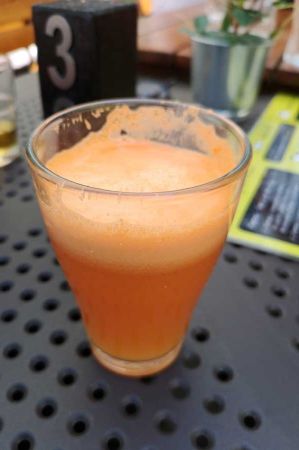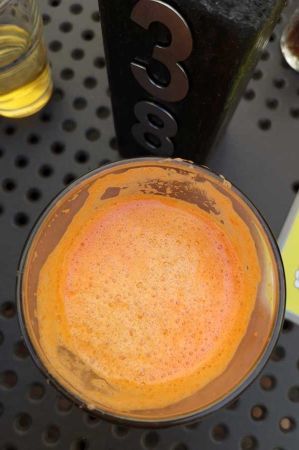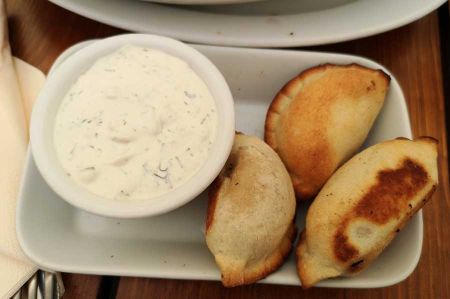Dumplings - with a colorful salad and carrot-ginger juice
- Written by Portal Editor
Traveling in Poland, it was a matter of course for us to use the stay in the port city of Gdynia not only for a tour along the harbor facilities and the exciting sandy beach, but also to visit a local restaurant to taste a typical Polish specialty: pierogi.
Pierogis are nowadays more widespread not just in Poland, the Czech Republic, Slovakia, Ukraine, Belarus, Russia and other Slavic countries, but also in Hungary, the Baltic States, Finland and Central Asia. Ukrainian and Mennonite immigrants also made them a very popular dish in Canada, where they can be found under the name of perogies with many different fillings in the freezers of every supermarket. In Germany, they are mainly known from the German-Baltic cuisine, where they are called Kurland bacon. German native speakers in Silesia also call them pirogues. In Russian, pirog today generally means cake, and with the derived diminutive piroshok, which is usually also translated as pirogue, meant baked, distinctly larger, stuffed dumplings to be eaten by hand and without sauce, butter or sour cream, which in Russia be eaten as a snack both warm and cold. The Polish Pierogi correspond to the popular slightly smaller pelmeni in the Ukraine, Russia and Belarus Wareniki.
But what is a pirogue - comparable to the Turkish Manti?
 The dumpling is a stuffed dough bag made of yeast, leaf or pasta dough, which is widely used in East-Central and Eastern European as well as Finnish cuisine. The type of production, fillings and designations vary from region to region. Dumplings are a popular part of festive meals, but are also offered by food stalls as fast food, called pierogarnia in Poland. They can be served as a starter, main course or dessert (sweet to tea).
The dumpling is a stuffed dough bag made of yeast, leaf or pasta dough, which is widely used in East-Central and Eastern European as well as Finnish cuisine. The type of production, fillings and designations vary from region to region. Dumplings are a popular part of festive meals, but are also offered by food stalls as fast food, called pierogarnia in Poland. They can be served as a starter, main course or dessert (sweet to tea).
Dumplings are relatively expensive to prepare, since they are filled and shaped by hand after the manual or machine done dough production. Therefore, they are traditionally made in community work. The raw dumplings are cooked in boiling water for a few minutes, fried in a pan with lard or baked in the oven. Similar to the Russian pelmeni, pierogi are sometimes served with fried onions and / or sour cream.
An Eastern Finnish variation is the Karelian pierogi (karjalanpiirakka), a small dumpling made from wafer-thin rye dough filled with barley porridge - but today mostly unsweetened rice pudding is used. It is traditionally topped with egg-nut or sausage or cheese and served like bread. Pastries with meat filling (lihapiirakka) are also widespread in Finland.
The main ingredients of the filling are variations with minced quark, white cottage cheese, bacon, potatoes, mushrooms, cabbage, spinach, sauerkraut or fruit. The Polish pierogi ruskie ("Ruthenian pierogi") contain a filling of potatoes and quark. The dumplings often form an independent dish - such as sautéed with glazed onions and sour cream.
Preparation of the pirogue dumplings
 First, the dough is prepared. To do this, sieve the flour into a bowl and add the egg, the oil and sip for sip the lukewarm water. Knead vigorously while doing so. The longer the dough is kneaded, the better it gets. It is said in the vernacular, about 10 minutes. Then cover the dough and let rest for about 30 minutes.
First, the dough is prepared. To do this, sieve the flour into a bowl and add the egg, the oil and sip for sip the lukewarm water. Knead vigorously while doing so. The longer the dough is kneaded, the better it gets. It is said in the vernacular, about 10 minutes. Then cover the dough and let rest for about 30 minutes.
For the filling, use sauerkraut, which is ready to serve. Dice the onions and mushrooms and fry in butter. Then add the sauerkraut. Simmer for about 10 minutes until the filling has a creamy texture. Season the filling with salt and pepper.
Bring water to a boil in a large pot add some salt. Roll out the dough about 2 mm thick on a floured surface and cut out with a glass to round thalers. Put some stuffing on the thalers and squeeze well. Decorate the edges with a fork. Pour the pierogi into the water, boil briefly and simmer over low heat until they float up.
Finally fry the pierogi in a pan with butter or oil from both sides. If you like, you can fry an onion and arrange them together on a plate.
Tip: I still find a second filling absolutely delicious. For this potatoes are cooked and mashed, seasoned with sour cream and parsley, salt and pepper. You can use anything that tastes in the recipe, sweet or savory.
For the dough:
500 g whole meal flour
1 egg (keep the amount of eggs as low as possible)
1 tsp oil
Lukewarm water (at will, but the dough should not be too soft)
Flour for the work surface
For the filling:
200 g sauerkraut, ready to serve
2 handfuls of mushrooms
1 small onion
salt and pepper
some oil or butter for frying
Please read as well:
Celery - a medicinal plant suitable for daily consumption
The bike project "Ciclovia Alpe Adria Cycle Path"
{gallery}pierogi-poland{/gallery}
